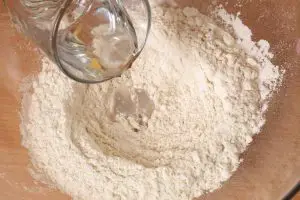There’s nothing quite like homemade bread, but it isn’t just the taste that makes homemade bread so popular. It is also the way it looks, and it is always much more aesthetically appealing when it has a golden-brown crust. When bread has a nice brown crust, it’s difficult not to jump right in and cut yourself a few slices, but what if that brown crust never happened?
The truth is that it’s easier than you think to determine what happened so that your bread comes out perfect the next go-around. Below are a few reasons why your bread might not have browned properly and what you can do about it.
Reason #1: You Didn’t Apply the Proper Wash
A wash is a layer made out of a beaten egg, whipped egg whites, or just plain water placed over the loaf of bread before you bake it. All you have to do is dip a plastic kitchen brush in one of these ingredients, then brush the top of your loaf with it. You don’t have to apply too much or it may affect the texture of the bread after it bakes, but apply enough for it to be noticeable.
Most of the time, the recipe will tell you exactly what the wash should be made of, but you can apply a light wash even if the recipe doesn’t call for one. Apply it to your bread after it rises the first time or right before you place it in the oven for baking.
Reason #2: You Didn’t Use High-Quality Ingredients
A loaf of bread is only as good as the ingredients inside of it, and it starts with making sure all of your ingredients are as fresh as possible. Always check your ingredients before you begin baking to make sure you are using ingredients that aren’t too old, or worse, have expired.
This sometimes happens with packets of yeast because it is easy to forget how long you’ve had them. If the eggs are near their expiration date or the flour smells funny, check into it so you can determine how to take care of the problem. Fresh ingredients are the only way to make sure that your loaf of bread comes out perfect every time.
Reason #3: There Is Something Wrong with Your Oven
Some people have problems with their oven and don’t realize it until a dish such as bread doesn’t turn out the way it should. Ovens run on cycles, taking turns between high temperatures to get things started and lower temperatures to make sure the food cooks evenly and thoroughly.
Sometimes the temperature can run high or low, and even if the difference is only by about 10 degrees, this can directly affect how brown your bread is. One way to tell if there’s something wrong with your oven is when other dishes come out either burnt or practically raw even when you know you set the timer correctly.
Reason #4: You Over-Proofed or Under-Proofed Your Bread
Don’t make the mistake of thinking that proofing your bread — which is taking steps to activate the yeast — isn’t important. After the first rise, the bread should be doubled in size. Then you’ll punch it down and let it rise a second time.
Both rises are important, and if you over- or under-proof your bread, you’ll notice that it may take longer to rise the second time. This in turn can directly affect how brown your bread gets. Always pay attention to the proofing directions in your recipe.
Reason #5: You Didn’t Use the Right Water with Your Yeast
When the recipe says to “add warm water” to your yeast, they’re not kidding. You cannot just take tap water at room temperature and assume your yeast will dissolve properly. Many recipes suggest warming up the water to around 80 degrees Fahrenheit, but trying to get the water to a temp of 90 to 100 degrees Fahrenheit is even better.
If it’s more than 100 degrees Fahrenheit, this can be too hot, but you never want to use water that is tepid or cool. A minimum temperature of 80 degrees Fahrenheit is a must to get the perfect dissolve rate for your yeast, which will affect how brown your bread gets.
Conclusion
Making homemade bread is part science and part art, and one of the first rules is to make sure that you follow the instructions to the letter. Any deviation in those instructions will affect how the bread looks and tastes in the end.
A nice brown crust is something all bread makers strive for, so it’s good to know that the solution to not getting this is very simple. You certainly do not have to be an expert to make a great loaf of bread, but you do have to make sure that every step in the directions is followed exactly as it is written. Otherwise, your bread will not turn out the way you like it.






